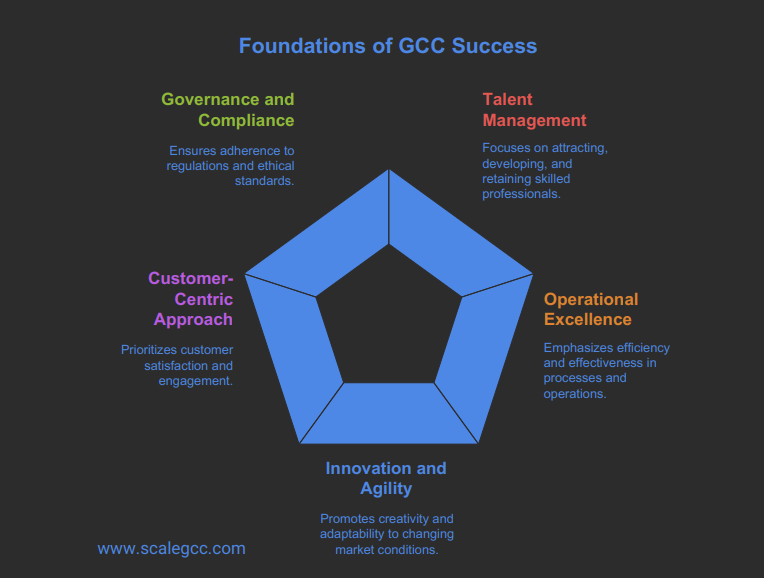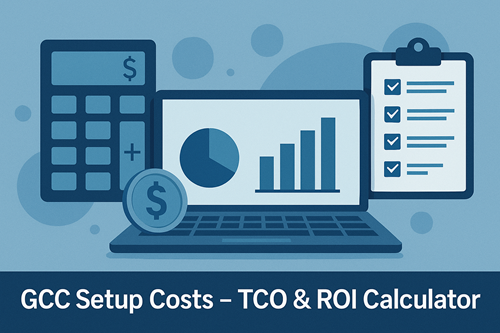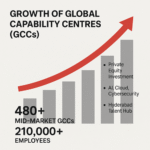Now Reading: GCC Strategy & Business Case Planning
-
01
GCC Strategy & Business Case Planning
As Global Capability Centers (GCCs) continue to evolve from support hubs into strategic assets, organizations must approach their setup and expansion with a clear strategic vision and a strong business case. This guide explores how GCC strategy and business case planning can unlock long-term enterprise value by aligning capabilities with global business goals, optimizing operations, and driving innovation at scale.
What Is GCC Strategy & Why It Matters
Defining the Direction for Scalable Growth – GCC strategy refers to the structured approach an organization takes to define the purpose, location, scope, and operational model of its global center. A strong strategy outlines how the GCC will serve enterprise goals, from cost optimization to digital innovation and workforce resilience.
Key benefits of GCC strategy:
Establishes clarity of purpose and scope
Supports talent planning and operational agility
Aligns with enterprise transformation roadmaps
Provides a basis for governance and compliance
What is a GCC Business Case?
A GCC business case justifies the setup and scaling of a Global Capability Center by detailing strategic goals, cost projections, ROI, and long-term value.
Why GCC Business Case Matters
A well-crafted business case is the foundation of any successful GCC initiative. It’s more than a spreadsheet, it’s a narrative that explains why the GCC exists, what it will deliver, and how it aligns with broader business objectives.
Key Reasons It Matters:
Secures Stakeholder Buy-In
Decision-makers need clarity and confidence. A robust business case shows executives, boards, and investors how the GCC contributes to enterprise growth, efficiency, and innovation not just cost cutting.Enables Data-Driven Investment Decisions
By detailing total cost of ownership (TCO), projected ROI, breakeven timelines, and risk scenarios, the business case becomes the cornerstone of responsible capital allocation.Drives Strategic Alignment
It links the GCC initiative directly to enterprise priorities whether it’s accelerating product development, enabling 24/7 operations, or becoming an AI innovation hub.Improves Transparency and Governance
A structured case defines who owns what, how success will be measured, and what governance frameworks will be in place. This helps reduce friction during execution.Facilitates Faster Scaling
With a clear roadmap in hand, organizations can scale their GCCs faster with fewer bottlenecks across talent, technology, and process areas.Helps Benchmark & Compare Vendors/Models
It becomes a reference point when evaluating outsourcing vs captive setups, nearshore vs offshore locations, or hybrid operating models.
What a Strong GCC Business Case Should Include:
Strategic rationale & market opportunity
TCO and 3–5 year ROI projections
Location analysis & talent cost-benefit
Risk assessment and mitigation strategy
Operating & governance model
Implementation timeline with milestones

Aligning GCCs with Business Goals
A successful GCC isn’t just a support hub, it’s a strategic extension of the enterprise. By aligning the GCC’s capabilities with core business objectives like digital transformation, market expansion, or customer experience, organizations can unlock greater agility, innovation, and operational efficiency. This alignment ensures the GCC drives measurable outcomes and remains relevant to evolving enterprise priorities.
An effective GCC strategy must support core business functions beyond IT like HR, Finance, Legal, R&D, and Analytics. When properly aligned, GCCs become innovation drivers, not just delivery engines.
Examples of alignment:
- Supporting 24/7 operations in BFSI
- Acting as AI/ML R&D hub for tech companies
- Enabling agile product launches in retail
- Providing multilingual CX for global markets
Strategic alignment boosts the credibility and value realization of your business case.
What to Avoid While Scaling Your GCC
Scaling a GCC without a clear roadmap can lead to inefficiencies, delays, and stakeholder resistance. Common pitfalls include over-prioritizing cost savings at the expense of long-term value, underestimating local talent dynamics, ignoring cultural integration, and lacking robust governance. To avoid these missteps, organizations should embrace phased scaling, align early with business units, and continuously evaluate performance against strategic goals.
Even the best-laid strategies can fail due to overlooked basics. Here are frequent issues:
- Cost-centric thinking only → Ignores innovation value
- No stakeholder alignment → Results in internal resistance
- Poor talent location research → Causes skill gaps and delays
- Generic operating models → Miss out on contextual agility
- Underestimating culture change → Disrupts onboarding
Solution: Conduct discovery workshops, build phased blueprints, and leverage benchmarks from successful GCCs.
Summary of Key Insights
Quick Recap for Leaders & Planners
- A defined GCC strategy aligns global talent, operations, and transformation goals
- A credible business case demonstrates value beyond cost think innovation, agility, and risk mitigation
- Alignment with enterprise vision makes a GCC a strategic enabler, not a side project
- Avoid pitfalls through real-world data, stakeholder input, and clear governance
Related Posts
Stay Informed With the Latest & Most Important News
Previous Post
Next Post
Interesting Read
Setup2 months ago
GCC Strategy & Business Case Planning
Tools2 months ago
GCC Setup Costs - TCO & ROI Calculator
Tools8 hours ago
Tech Skills Readiness Analyzer
Tools14 hours ago
GCC Career Readiness Scorecard















